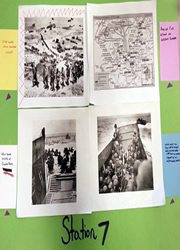Summary
Imagine walking up to a photo on a wall, pulling out your phone to scan it, and receiving all kinds of extra information right there on your device. In this lesson, a history class creates guided videos for primary source documents (photos) from World War II. One class prepares a guided tour of the major events in WWII for other history classes. Students combine photos and videos into an “aura” on Aurasma. Other classes then look for the clues with Aurasma while answering questions. Other classes will also evaluate the original creator’s work.
TIPC Ratings
7 – Ideal: In this lesson, students assembled resources that were collected by the teacher and resources on their own. The task required synthesis of these resources to address the authentic task (teaching other classes about World War II). They utilized past knowledge in assessing validity of resources used. Students came up with their own questions related to the events in World War II. Students used digital tools to display and interact with information related to World War II.
7 – Ideal: In this lesson, the students selected their own groups based upon interest. They used a variety of tools to communicate and collaborate digitally within their group and to other classes in the school or even globally. The students are increasing communication skills as they collaborate on this project to create meaningful student work.
From the reflection students provided, it was clear that several of them stepped outside of their comfort zones with things like being on camera to complete the project. Students also identified goals for future projects that involve collaboration.
6 – Ideal: Students generated and responded to purposeful questions (what were the most important details surrounding the major events of World War II?). Students also had to apply critical thinking skills in developing an activity for peers by using a variety of digital tools to solve the central task. Students worked within the restraints of the tools they had available and discussed alternatives to these tools. They had to solve numerous logistical problems with technology as we did the project and came up with solutions. This lesson put the students into the role of teachers and raised the level of critical thinking.
6 – Ideal: Students create stations for the assignment for other students. They had to be innovative to ensure that other classes could solve their clues.They created meaningful and original work with videos, clues, questions, and posters. They had to conduct and summarize research. They communicated and collaborated digitally while solving the central problem. The video creation portion allowed students to be innovative in the way they share information. Many of the groups took a risk in doing the video their own way. Some groups even did their own auditions within the groups to figure out who was the best speaker.
Student Artifacts
Download Files

Contents:
-
There are no downloads. Please select items below:
- Lesson Plan
- Project Website




